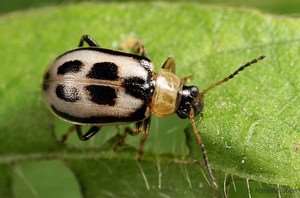Field Guide  Pest Management
Pest Management  Bean Leaf Beetle
Bean Leaf Beetle
Bean Leaf Beetle
CROPS IMPACTED: Soybeans, snap beans and leguminous plants
 | |
Family: Chrysomelidae (Leaf Beetles) |
  |
About Bean Leaf Beetles
Reproduction and Life Cycle
Bean leaf beetles overwinter in soil, grass clumps, under leaves, or in leaf debris in woodlots. These beetles will surface anywhere from the middle of May to the beginning of June. Their first priority is to feed, and then afterwards they will begin to mate. The female beetle will produce approximately 12 eggs, which she will lay in the soil near bean plants. These eggs will take 1-3 weeks to hatch, depending on environmental conditions. When the larvae hatch, they gain their nutrients from feeding off of the bean plants roots. This feeding has not shown to be significantly detrimental to the beans growth. Bean leaf beetles remain in the larva stage for about 2-3 weeks, and will then enter the pupal stage of development in the soil. Larvae tend to only survive in soil that is highly organic (about 66%). They will surface as fully grown adults from July to August. Typically, there is only one generation each year; however, in more southern areas 2 generations are possible. In this case, one generation of adults will emerge in July and the second in August or September.
Bean Leaf Beetle Identification and Habitat
Identification
The bean leaf beetle is usually 4-9mm in length and oval-shaped. They tend to be yellow, red, orange, or anywhere in-between with black markings that are often seen as four spots on the wing covers. However, sometimes there are only 2 spots or no spots at all. The females have black heads while the males generally have a brown facial area. The common characteristic that all bean leaf beetles have is a black triangle in the neck region on the wing covers. Males have a thick set of hairs on the first segment of their forelegs, which assist them to grip a female while mating. The egg of a bean leaf beetle is a short few millimeters in length, spike shaped and orange to yellow in colour. The larvae are cylindrical and white. The last segment of their body and head is a dark brown. When the larvae enter the pupal stage of development, it will bear a resemblance to the shape of a fully grown bean leaf beetle and is coloured white. This beetle can only fly short distances.
Habitat
Bean leaf beetles are commonly found in soybean fields, or among the leaves of legumes. These beetles are found throughout the United States in the northcentral areas. They have also been spotted in Manitoba and Ontario, Canada. The adult beetles tend to prefer young soybean plants. They will feed on the underside of the leaf, creating small, round holes. This is particularly detrimental to the plants when they are young, as large amounts of beetles present can destroy the first leaves of seedlings and kill the plant, resulting in a poor crop yield. If the beetles present themselves at the plants development stage when it forms pods, adults will still feed on the external surface, but usually do not damage the seeds. While the beetles usually first appear before soybean plants emerge, a high abundance of beetles can correspond with soybean emergence. Mild winters and sufficient snow cover to protect the overwintering adults can result in an increase in population the following year. If temperatures reach below 14 degrees Fahrenheit, the beetle will not be able to survive.
Bean Leaf Beetle Management and Control Methods
Management
Aside from the fact that beetles will eat away at soybean plants, they can also transmit a virus to the plant called bean pod mottle virus, which is mainly a concern for farmers who sell their soybeans for food as it affects the seed coat quality. This virus can also reduce crop yield, making it important for you to have proper management tactics in order to minimize beetle populations that are present in your soybeans. Having satisfactory control is dependent on using an integrated management system that includes the use of cultural and chemical methods.
Cultural Control
Cold winters can effectively keep bean leaf beetle populations to a minimum. When this is not the case, soybeans planted at a later time can help reduce plant damage; usually the plants that emerge first in a region are the most susceptible to harm.
Chemical Control
Be sure to carefully read the label for cautions and proper application. It is extremely important to never spray on days that are windy. There are currently no sprays available to control bean pod mottle virus; however, there is insecticide available to help control the population of bean leaf beetles. Pyrethrold sprays have been found to be effective with 2 applications per season; one upon the emergence of the overwintered beetles, and one at the emergence of beetles in July from that season’s first generation.
Biocontrols
Spined soldier bugs, ladybugs, and ground beetles’ prey on bean leaf beetles, limiting their population. Parasitic tachinid flies target adult beetles, using them as hosts for their larvae. Additionally, entomopathogenic fungi such as Beauveria bassiana and Metarhizium anisopliae infect and kill bean leaf beetles under suitable conditions. Nematodes (Steinernema and Heterorhabditis species) attack larvae in the soil, preventing them from reaching adulthood. These bio controls are used in field crops.
Latin / Alternative Bean Leaf Beetle Names
Sources
http://bugguide.net/node/view/6903
https://www.ent.iastate.edu/soybeaninsects/BLB_description